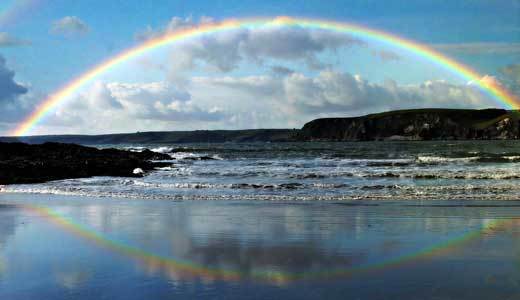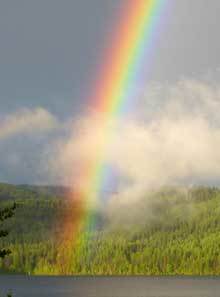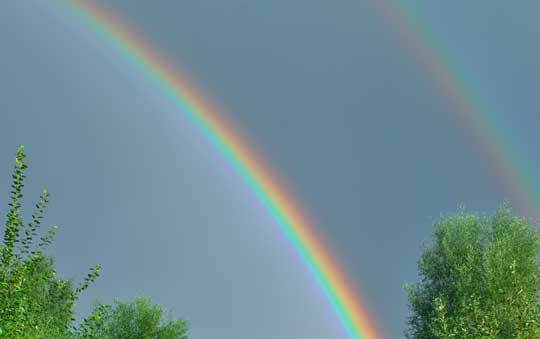The Rainbow – Explaining One Of Nature’s Most Spectacular Displays

Rainbows are, without doubt, one of the most photographed and well-known meteorological phenomena on Earth. But what exactly are these events, how do they develop & what causes their unique characteristics?
A rainbow is defined as an optical meteorological event that occurs when water droplets in the atmosphere refract, reflect, and scatter sunlight into its spectral colors, which appear as a multicolored arc. It typically occurs when direct sunlight and raindrops are simultaneously present in the sky.
Almost every human on the planet is familiar with the multicolored arc of a rainbow formation spanning across the sky. Even the few readers who never observed one have probably seen several images and illustrations of this meteorological phenomenon.
Although it usually occurs on a rainy day when the sun breaks through the clouds, it can also happen under similar conditions when water droplets in the air come into contact and transform sunlight.
This post examines what a rainbow is, how it is formed and looks at the different types of rainbows. It also highlights the key facts that define this meteorological phenomenon.
What Is A Rainbow?
Before one can start looking at the formation of a rainbow and the key facts that define it, one needs a more elaborate definition of the phenomenon. The introduction already provided a brief description, but a more comprehensive description of a rainbow:
Rainbow Definition

A rainbow is an optical meteorological phenomenon that occurs when water droplets in the atmosphere refract, reflect, and disperse sunlight into its spectral colors, which appear as a multicolored semicircular arc to an observer close to the horizon.
A rainbow typically develops when direct sunlight and raindrops are simultaneously present in the atmosphere on opposite sides of the sky. Its appearance results from sunlight being reflected by water droplets at an angle of between 40° to 42° to the observer.
The word "rainbow" originated from the Latin word "arcus pluvius", which literally translates to "rainy arch."
A rainbow is a meteorological phenomenon that is, in fact, nothing more than an optical illusion. It is not an actual physical object and also has no physical location. It is simply light being reflected and dispersed that, under the right conditions, reach an observer's location.
It typically appears when raindrops are present in the air and are exposed to (usually) direct sunlight low on the horizon on the opposite side of the sky. This explains why rainbows normally appear in the west in the morning and the east in the late afternoon.

The multicolored arc one observes is a result of sunlight refracted and reflecting off the back of a water droplet, which also disperses the white sunlight and breaks it up into its seven spectral colors (red, orange, yellow, green, blue, indigo, and violet.)
Red (the color with the longest wavelength) bends at an angle of 42 degrees and appears on the outer edge of the bow, while violet (the color with the shortest wavelength) bends at an angle of 40 degrees and appears on the inner edge of the arc.
All rainbows are technically in the shape of a full circle, but since they occur so close to the ground, one only observes the arc visible above the horizon. The antisolar point, the theoretical center of a rainbow, is almost always positioned at a point below the horizon.
A rainbow and sun always appear on the opposite sides of the sky. As a result, when viewing a rainbow, an observer will always be standing with his/her back to the sun. (Sunlight travels past the onlooker, which gets reflected and dispersed by water droplets back to the viewer.)
Rainbow Formation: How A Rainbow Develops
With a better understanding of what a rainbow is and the characteristics that define it, one needs to look at how a rainbow is formed to clarify why and how it occurs. The following steps detail the progression in the development of a rainbow:

Illustration demonstrating the path of sunlight through a water droplet to explain the formation of a rainbow. Click on the image for a larger view.
- 1For a rainbow to develop, both water droplets as well as (direct) sunlight need to be present in the air.
- 2With the sun and water droplets situated on opposite sides of the sky, sunlight travels through the atmosphere until encountering and hitting the surface of individual water drops, typically in the form of a rain shower.
- 3Water has a different density than air. As a result, sunlight is bend (refracted) as it enters a water droplet.
- 4Inside the droplet, the light also gets dispersed (broken up) into its spectral colors (red, orange, yellow, green, blue, indigo, and violet), which is responsible for the multicolored band of a rainbow.
- 5Dispersed light continues to travel through the droplet until it reaches the back of the water drop, where it gets refracted and reflected at an angle of between 40 and 42 degrees from the direction the sunlight entered the water droplet.
- 6The reflected, dispersed light continues to travel back to the surface where an observer, positioned at the right location to view the incoming rays, view it as the familiar multicolored arc that constitutes a rainbow.
- 7The size of the water droplet determines the size or radius of a rainbow. This is a result of the water droplet's refractive index (the measurement of how much light is bent as it passes through a medium.)
- 8Observers view rainbows as an arc because the droplets opposite the sun reflect the light back to the viewer at approximately 42 degrees all around. (Rainbows form an imaginary circle, but one only sees the arc visible above the horizon.)
There are other processes involved in the formation of a rainbow and also more factors influencing its appearance, but these are the key steps involved in the development of this meteorological phenomenon.
Types Of Rainbows
Although the principles defining a rainbow and its formation remain the shape, small variations and additional factors can result in different types of rainbows. The following are some of the most common types of rainbows besides primary rainbows:

A typical example of a double rainbow.
There are even more variations on the primary type of rainbow, but these are some of the most commonly observed variations.
Rainbow Facts
Previous sections of this article already addressed the definition and formation of a rainbow. The following list provides the reader with some of the key facts and characteristics that define a rainbow:
- 1A rainbow is an optical meteorological phenomenon that occurs when water droplets refract, reflect, and disperse sunlight at an angle of 42 degrees to an observer on the ground.
- 2The multicolored arc is a result of water drops breaking (dispersing) the white sunlight into its spectral colors and reflecting it back to observers on the ground.
- 3The size of a water droplet determines the radius/size of a rainbow. This is a result of water's refractive index.
- 4The size of a water droplet also determines the brightness of a rainbow. Water drops larger than 1 millimeter in size produce much brighter and well-defined colors than smaller droplets.
- 5A rainbow is not an actual physical object and can never be reached.
- 6All rainbows are technically in the shape of a full circle, but one only observes the arc visible above the horizon since the observer is usually situated on or close to the planet's surface.
- 7The theoretical center of a rainbow is called the antisolar point. (The position exactly opposite the sun.)
- 8A rainbow-producing water droplet can have more than one internal reflection, resulting in a double rainbow.
- 9A rainbow and the sun always appear on the opposite sides of the sky. (The sun is to the back of the observer viewing the rainbow.)
- 10Several different types of rainbows exist, including double rainbows, supernumerary rainbows, twinned rainbows, and full-circle rainbows.
- 11In Norse Mythology, rainbows were seen as a bridge (called the Bifröst) connecting mortal Earth (called Midgard) to the gods (in a location called (Asgard.)
- 12The dark piece of sky that exists between a primary and secondary rainbow is called Alexander's band.
- 13The longest-observed rainbow ever occurred in Taiwan on November 30, 2017. It lasted for almost 9 hours (8 hours 58 minutes).
Although this list does not contain all the data available about rainbows, it highlights the key facts and characteristics of this optical phenomenon.
Conclusion
As this article illustrated, although a rainbow can sometimes appear almost magical and supernatural, it is a simple optical, meteorological phenomenon that results from the refraction, reflection, and dispersion of sunlight by water droplets in the atmosphere.
This article described what exactly a rainbow is and how it develops. It also looked at the different types of rainbows, as well as the key facts defining this optical phenomenon.
Never miss out again when another interesting and helpful article is released and stay updated, while also receiving helpful tips & information by simply following this link .
Until next time, keep your eye on the weather!

